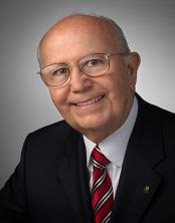(Ed.'s Note: We first published the generous franchise granted by the Brownsville Navigation District to the Brode Group's OmniTrax III to take over the operations (and everything else except the tracks) of the Brownsville-Rio Grande International Railroad for promises of good jobs and the establishment of an Industrial Park. After a year, a Master Plan was to be produced and the goodies start flowing to the port and its taxpayers and workers. It's been more than two years and we have not heard anything about the progress being made, if any. Although the local daily is filled with glowing reports on the port's progress, blessed little is said about the OmniTrax franchise results. This is what we bought into. Was it worth it?)By
Juan MontoyaNow that we have acquired a copy of the proposed franchise that the Brownsville Navigation District wants to grant Colorado-based OmniTrax III, we have a good idea of what the port will get and what the company will get in return.
The Company will get:– A 30-year franchise agreement on leasing 1,200 acres of land for which it will pay $3,693 a month
– Exclusive use of the Brownsville Rio Grande International Railroad's 45 miles of track throughout the Brownsville Navigation District and 5 miles into the city of Brownsville itself. The BRG has six yards and more than 1,000 cars on hand. It boasts of being "armed with an array of services to offer shippers anywhere in the United States. Steel, scrap metal, agricultural and food products and other bulk materials have always been major commodities for the BRG, but chemical shipments have skyrocketed in recent years."
![]()
– It will pay only $2.5 million for the port's eight large locomotives, five smaller yard engines, railroad machinery, track hand tools, all the tools and machinery in the railroad's mechanical department, and all the rolling stock that includes 29 vehicles ranging from 21 pickup trucks, an electric hydraulic tire crane vehicle, and at least four heavy duty trailers. However, only $500,000 will be paid within 30 days of the commencement date and $2 million will be paid in seven equal yearly installments of $285,714 each starting one year from the agreement.
– A non-competitive franchise to all the Port's customers (its tenants)
– A promise by the district that it agrees to cooperate with OmniTrax to minimize or eliminate property, ad valorem, value added taxes, and similar taxes potentially or actually assessable to OmniTrax. Any taxes that are assessed, however, shall be the company's responsibility.
– The right to use without separate compensation or payment, the trade names Brownsville and Rio Grande International Railroad and BRG, car marks, trademarks, copyrights, and other intellectual property associated with the railroad.
– The right to use all market information, market analyses, marketing plans, customer information, operating or management policies, procedures and forms within the custody, control, or possession of the BGR Railroad used or developed for use in the operation of the BGR Railroad.
– Customer lists, supplier lists, distributor lists, purchase and sales records, blueprints, specifications, personnel and labor relations records, environmental control records, accounting and financial records, maintenance records, operations and management manuals, computer systems and software documentation, blank forms and plans and designs of products and equipment.
– The district will pay up to $1 million in out-of-pocket marketing expenses for the Industrial Park development area."
– The district shall grant the company "credit against the franchise consideration (of $8.5 million) " for:
– direct investment in the common elements as shown in the Master Plan which will be formulated within one year of the agreement date
– District will also share costs for tenant/user investment in the common elements as shown on the Master Plan
– District will also share costs in the amounts paid for engineering and related professional consulting services for the common elements as shown on the Master Plan
– District will also share in the costs for development of infrastructure for the Incubator Site (227 ares) not specifically dedicated to an individual tenant or user (e.g., trackage, scale, and other common elements)
– If OmniTrax fails to satisfactorily perform with respect to the Franchise consideration ($8.5 million) the Port may terminate OminTrax's exclusive rights to the percentage of undeveloped and unimproved acreage in the Industrial Park. This shortfall in the consideration below $8.5 million based on a formula. For example, if if by the end of the five years the total paid has been $6.8 million, OmniTrax shall either post a bond to the district in the amount of $1.7 million, district can terminate OmniTrax exclusive rights to 20 percent of the undeveloped land.
– District will apply for state and federal grant funding for common elements of the Industrial Park
– And if the port decides that want to sell the railroad, or part of it, OmniTrax wants the rights of first refusal to buy it from the port.
– As far as the Master Plan, OmniTrax requires sole discretion in planning and implementing it but agrees to submit the proposals to the board of commissioners for approval. It will charge a Common Area Maintenance charge to all its tenants. However, if there are insufficient funds for the cost of maintenance, the excess costs shall be divided between OmniTrax and the district.
What the Port will get:– OmniTrax agrees to "contribute and attract" not less than $8.5 million of direct capital investment in the common elements of the Industrial Park during the period of five years following the acceptance of a Master Plan to be produced by OmniTrax
– OmniTrax promises to produce the Master Plan one year after the acceptance date of the franchise agreement
– $3,693 a month rent on 1,200 acres of land
![]()
– OmniTrax will pay the district $10,714 per month rent on the railroad's buildings and locomotive pit for seven years. Upon payment of 7 years rent ($900,000), OmniTrax will own free and clear, all rights and title to real estate listed, not including the land itself. This includes two steel warehouses, the administration building, back office additions, engineers' lunch rooms, an open warehouse for heavy equipment and diesel track, main office vehicle maintenance warehouse, and a diesel track warehouse built in 2011.
– 1. A fee for each loaded railcar (including an empty car delivered to a district lessee for the purpose of dismantling) originated or terminated on the BRG yard.
– $20 for each loaded railcar for the first $35,000 cars per year
– $25 for each loaded railcar above$35 cars per year, and
– Beginning on the sixth anniversary of the Commencement Date, OmniTrax shall pay 5 percent of the gross revenues from railroad operations above $10,500,000 per year.
– In no event shall the annual loaded railcar revenue paid by OmniTrax to district under #1 be less than $550,000.
– OminTrax shall not increase the rates in public tariffs issued by the franchisee which are charged to existing BRG customers, or their successors or assigns to an existing facility at the port...without the consent of the Board of Commissioners. Nothing in this section shall restrict the ability of OmniTrax to charge a special rate for additional services provided to a BRG customer, or to enter into future Transportation Service Agreements with existing or new customers."
– The agreement also calls for all BRG employees to be transferred to it and become its employees "subject to the results of drug testing, criminal background checks, and post-employment physical abilities testing."
Upon becoming OmniTrax employees, they will maintain their same level of seniority, level of service, and similar compensation and benefits."
– OmniTrax also is beholden to assume the Junior Lien Bonds Series 2003 issued by BRG for rail improvements. It assumes all payments on those bonds as they become due as of the effective date of the agreement not to exceed $2.228 million excluding late fees.
– The so-called incubator parcel consisting of 227 acres will be exclusively developed, used and operated by OmniTrax and it will develop, construct, market, and operate it at its sole expense. Upon receiving rental income from the first user, it will pay the district $500 per acre per year based on the actual acreage.
–
OmniTrax will begin construction of the Incubator Site within 365 days of the commencement date of the agreement. Any portion of the incubator site not developed within five years after the agreement is signed shall be added to the Industrial Park.































